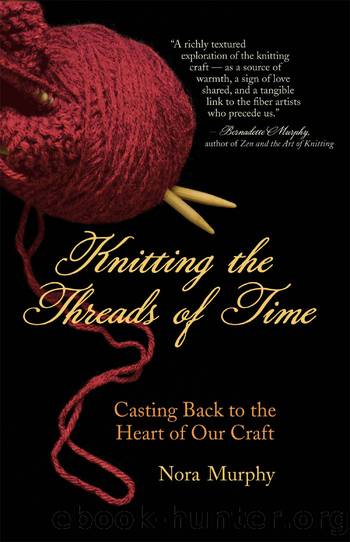Knitting the Threads of Time by Nora Murphy

Author:Nora Murphy
Language: eng
Format: epub
ISBN: 9781577318446
Publisher: New World Library
Kongâs Café
One time this guy I dated in college asked me if I would stay with him if he were impotent,â says Betty, leaning into the booth where three of us are having lunch, a few days before Christmas at Kongâs Café on Lake Street, just across the Mississippi River in Minneapolis.
âHah!â we all laugh in unison.
This is a reunion lunch prompted by Janetâs trip to Minneapolis to visit her oldest daughter. Ten years ago, the three of us worked together at the Minneapolis American Indian Center for an after-school Native youth program. I keep reminders of Betty and Janet with me every day. Betty beaded the keychain I use, and Janet gave me a beaded pen. I call it the âmiracle penâ because after all these years, the ink still hasnât run dry.
Our laughter over this Christmas lunch balances out the tough things weâve been talking about â going through divorce, and figuring out how to balance taking good care of our kids with taking care of ourselves. We talk about our new relationships. Are we falling into old traps or staying true to ourselves?
Betty pushes away her wonton soup and asks, âSo howâs the keychain â still in good shape?â
âYeah, itâs great. Except, well, I messed it up myself,â I say, pulling her handiwork out of my purse. âSee here, I accidentally slipped a key under the top row. A few beads are coming loose.â We all stare at the keychain. Itâs shaped like a cylinder, with beads of blues, white, and black forming diagonal streaks of lightning.
âI love how this one shines so much â see that,â I say, twisting it around. Even in the dim light of Kongâs Café, the beads glisten.
As in Africa, Asia, Europe, and Latin America, the ancient textile traditions of weaving and decorative arts are rich in North America. Beadwork by Ojibwe women like Betty and Janet demonstrates that indigenous women are keeping these traditions alive and well in the twenty-first century.
Long before the Spanish or other Europeans arrived, indigenous people along the northwestern coast of North America made yarn and wove cloth. Their traditions of weaving, some still in use today, resonate with the themes found in fiber history around the world. Like the embroidered Hmong paj ntaub, the Pacific tribal weaving told the peopleâs history. Their textiles carried the sacred power of regeneration like the cloak of the Middle Eastern goddess Ishtar. Their weavings were used in sacred dances like those conducted in ancient Europe. Pacific coastal weaving twined the sacred power of the maker with the sacred power of the creator, like that first knitted sock in Egypt. Like the Incas to the south, the Northwest coastal weavers incorporated clean yet mesmerizing geometric designs.
Among the best known of these indigenous Pacific weavers are the Tlingit, who live in present-day western Alaska and Canada. Tlingit weavers are known for being the only people in the world who can weave a perfect circle by hand. Contemporary Tlingit weavers still weave with yarn made from a mix of softened cedar bark, which is rain-resistant, and mountain-goat hair.
Download
This site does not store any files on its server. We only index and link to content provided by other sites. Please contact the content providers to delete copyright contents if any and email us, we'll remove relevant links or contents immediately.
How to Embroider Almost Every Cute Thing by Nihon Vogue(425)
The Pocket Guide to Fishing Knots: A Step-by-Step Guide to the Most Important Knots for Fresh and Salt Water - PDFDrive.com by Joseph B. Healy(341)
Ultimate Book of Everyday Knots by Geoffrey Budworth(238)
280 Japanese Lace Stitches by Nihon Vogue(236)
Crochet Collage Garden by Chris Norrington(233)
vogue knitting beginner basics by Unknown(229)
100 Crochet Tiles by Various(228)
The Ultimate All-Around Stitch Dictionary by Bernard Wendy;(226)
Spooktacular Crochet by Annie's(221)
Adding Layers—Color, Design & Imagination by Kathy Doughty(204)
Crochet Your Own Kawaii Animal Cuties by Katalin Galusz(195)
Christmas Amigurumi--5 Crochet Patterns by Sayjai Thawornsupacharoen(194)
Better Homes & Gardens Can It! by Unknown(194)
Super Easy Crochet for Beginners by Burger Deborah;(188)
Traditional Knitting Patterns by James Norbury(185)
Satisfying Stitches by Hope Brasfield(183)
Crochet Wraps Every Which Way by Tammy Hildebrand(181)
Quick Crochet for Kitchen and Home by Salena Baca & DANYEL PINK & EMILY TRUMAN(178)
More Stunning Stitches for Crazy Quilts by Kathy Seaman Shaw(171)
